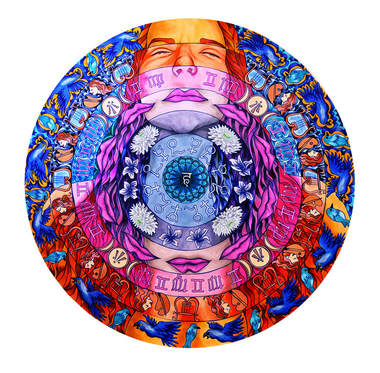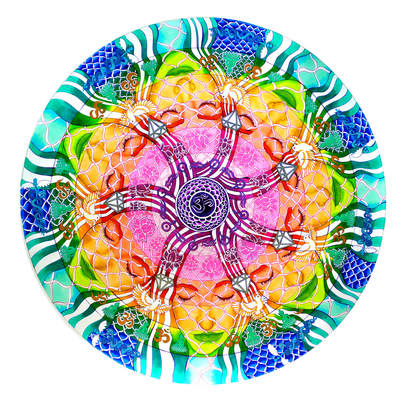- Meet Karla
- Free Guided Meditations
- Events & Workshops
- Get Your Free E-Book Breathing Lessons
- Work With Me
- Ketamine Assisted Psychotherapy (KAP)
- Reiki
- Tarot
- Chakras
- Yoga Nidra
- Frequently Asked Questions
- Just Breathe
- Altars and Shrines
- Tips & Articles
- Gift Certificates
- Press and News
- Blog: The Therapeutic Life
- The Mind in Grief
- Grounding
Circles of the Self ~ Mandala Assessment
This creative, intuitive, assessment tool is based on the ancient concept of the mandala blended with the work of Carl Jung, famed Swiss psychiatrist, and the collective cultural, mythical information that he synthesized, resulting in what our culture now recognizes as the "collective unconcsious."
The assessment asks you to create a mandala and also to choose from 39 other mandala representations, those symbols which most appeal to you, as well as one you reject. It also asks that you match your choices with colors. The resulting information reveals what Jung called "coded messages from the inner self."
Through your own choices of universal symbols and individual colors, you provide for your own self a kind of map of awareness; a map that can show yourself where you've been, where you are right now, giving clue to where you might be headed.
The assessment asks you to create a mandala and also to choose from 39 other mandala representations, those symbols which most appeal to you, as well as one you reject. It also asks that you match your choices with colors. The resulting information reveals what Jung called "coded messages from the inner self."
Through your own choices of universal symbols and individual colors, you provide for your own self a kind of map of awareness; a map that can show yourself where you've been, where you are right now, giving clue to where you might be headed.
In the Sanskrit language, mandala means circle. Mandala art is anything that is drawn, painted, collaged, created inside a circular shape or form. Tibetan Buddhism has used mandala art as a form of meditation for thousands of years. Navajo sand painters use them in healing rites. The shape of the mandala recalls the Medicine Wheel used by many native people to connect to nature wisdom.
The round shape of the circle, the mandala, allows us to experience wholeness--there is no up or down, top or bottom. Classical use of the mandala, has the artist/meditator begining with a central point. In yoga, the bindu—a point of intense focus. From that bindu point, the design of the classical mandala radiates. It is used as a tool for meditation during and after creation.
The circle and mandala shape is found all through nature, from the structure of cells, to solar systems. We see it in seashells, tree trunks, flowers, wind patterns, the concentric rings that move from center after a pebble is dropped into a puddle. A circle can expand without strain, and there is no point on a circle that is stronger than another.
The round shape of the circle, the mandala, allows us to experience wholeness--there is no up or down, top or bottom. Classical use of the mandala, has the artist/meditator begining with a central point. In yoga, the bindu—a point of intense focus. From that bindu point, the design of the classical mandala radiates. It is used as a tool for meditation during and after creation.
The circle and mandala shape is found all through nature, from the structure of cells, to solar systems. We see it in seashells, tree trunks, flowers, wind patterns, the concentric rings that move from center after a pebble is dropped into a puddle. A circle can expand without strain, and there is no point on a circle that is stronger than another.
© Karla Helbert, MS, LPC All Rights Reserved
- Meet Karla
- Free Guided Meditations
- Events & Workshops
- Get Your Free E-Book Breathing Lessons
- Work With Me
- Ketamine Assisted Psychotherapy (KAP)
- Reiki
- Tarot
- Chakras
- Yoga Nidra
- Frequently Asked Questions
- Just Breathe
- Altars and Shrines
- Tips & Articles
- Gift Certificates
- Press and News
- Blog: The Therapeutic Life
- The Mind in Grief
- Grounding

